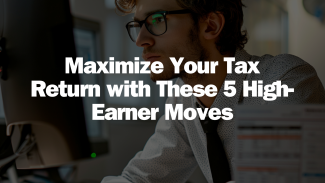
5 Smart High-Earner Moves to Maximize Your Tax Return
Employees have several unique, often-overlooked tax strategies that could potentially add hundreds of thousands of dollars to their bank account by retirement.
For starters, how confident are you that you correctly filed the best possible tax return last year, legally leveraging all the available tax credits, deductions, and strategies?
Like many, you might be left with a nagging feeling that you could have saved more.
Don’t stress too much about it. If you’re burnt out from sprinting to file this year, just give me five minutes; it’ll be worth it!
People would rather slightly overpay on taxes than risk the time-suck of a dreaded audit that could come with pushing the tax return boundaries.
Information is crucial, but it can be daunting to navigate hundreds of pages of IRS documents and forms annually to catch the latest updates. For example, the guide on residential rental properties, IRS Publication 527, is 38 pages long.
For high-salary employees especially, strategic tax planning transcends mere avoidance of overpayment– it's about taking ownership of one of the most critical aspects of your sophisticated financial landscape.
Proactive tax planning allows you to redirect funds from tax payments to wealth-building avenues, accelerating wealth accumulation and investment potential or even just elevating your lifestyle aspirations.
The proactive tax planning imperative extends beyond the fear of leaving money on the table—it’s about following your nose to seize every opportunity that could enhance, preserve, and magnify the impact of the hard work you put in every day of the calendar year.
Here are five savvy moves for W-2 employees to plan around and execute throughout 2024 to increase their tax returns in 2025.
1. Max Out Your Retirement Contributions
Some of the lowest fruit available is pumping up your 401(k) contributions to the maximum, especially if your employer offers a 401(k) match.
The 401(k) limit is increasing to $23,000 for 2024 (and the IRA limit is rising to $7,000)
So, this year, toss up to $23,000 into your 401(k) if you're under 50. Over 50? You're allowed a catch-up contribution, pushing your limit to $30,500.
Every dollar you contribute reduces your taxable income, potentially nudging you into a lower tax bracket and growing your nest egg tax-deferred.
Your next (and non-obvious) move should be… to email or schedule a meeting with your HR or payroll department to review your current 401(k) contribution settings. Whether you do it via email or meeting doesn’t really matter, but make sure your contributions are adjusted to meet the new limits and optimize employer matching, if available.
This way, you’ll make sure that the increase is properly set up in your payroll system and set to begin the next paycheck, maximizing the benefit throughout the year and avoiding a last-minute scramble to catch up on contributions at year-end. This will most likely be automated, but at the very least, you’ll touch base with your plan!
2. Explore the Mega Backdoor Roth IRA
Since we’re on the topic of 401(k)s– you need to know about the Mega Backdoor Roth IRA.
The Mega Backdoor Roth IRA allows you to significantly increase the amount you contribute to your Roth IRA beyond the standard limits– up to a total of $69,000 that can be moved into a Roth account.
By making after-tax contributions to your 401(k) and converting these funds to a Roth IRA, you benefit from tax-free growth and withdrawals in retirement. This strategy is particularly valuable if you are looking to maximize your retirement savings and are already contributing the maximum pre-tax amount to your 401(k).]
If your employer's plan permits, a Mega Backdoor Roth IRA strategy involves making after-tax contributions into your 401(k), which you can then convert to a Roth IRA, where earnings grow tax-free.
If you don’t have an eligible 401(k), you can also do a standard Backdoor Roth to contribute to a Roth, albeit at lower limits.
Your next (and non-obvious) move should be… to contact your employer’s benefits administrator or plan provider to confirm whether your current 401(k) plan supports after-tax contributions and in-service withdrawals, which are essential for executing the Mega Backdoor Roth IRA strategy.
This information helps determine whether you can proceed with this strategy and, if not, advocate for changes within your benefits package. Further, penciling some time in your calendar to discuss the basic applications of Mega Backdoor Roth can help you understand if you even qualify and what you need to do.
3. Utilize a Health Savings Account (HSA)
If you're enrolled in a high-deductible health plan (HDHP), fully fund your HSA– it can be a fantastic three-piece combo: your contributions reduce taxable income, the money grows tax-free, and withdrawals for qualified medical expenses are tax-free, too.
If this is your first time being exposed to an HSA in-depth, it’s defined by the IRS as “a tax-exempt trust or custodial account you set up with a qualified HSA trustee to pay or reimburse certain medical expenses you incur.”
It’s a powerful way to save for healthcare costs now and in retirement while lowering your current tax bill.
Your next (and non-obvious) move should be… taking the time to fully understand your current plan and assessing your healthcare needs and financial goals.
If you’re enrolled in an HDHP, maximize your HSA contributions for optimal tax advantage and future healthcare savings.
If you don’t have an HSA, consider enrolling in one during your next open enrollment period and simultaneously set up an HSA.
4. Invest in Opportunity Zones
Investments in Opportunity Zones offer the potential to defer and reduce taxes on prior gains for those willing to commit to long-term holdings.
However, note that the process involves complex regulations that necessitate careful strategic planning and professional advice to ensure compliance and maximize benefits.
Your next (and non-obvious) move should be to… research and identify zones that align with personal investment goals.
There are several resources worth digging into:
- The U.S. Economic Development Administration provides detailed maps and lists of designated zones.
- The IRS website offers crucial guidance on tax benefits and compliance requirements; detailed guidance is on the IRS's page here.
- Dedicated platforms like OpportunityDb serve as valuable sources of information and analytics on specific projects. Their website is here.
- Commercial real estate platforms, such as Fundrise or RealtyMogul, frequently update on investment opportunities and trends within these zones.
- On occasion, financial news sites like Bloomberg and Forbes provide updates and analyses on developments within Opportunity Zones, which can be helpful for staying informed about emerging opportunities and trends.
5. Practice Tax-Loss Harvesting
Work with your financial advisor to sell off underperforming investments and realize losses that can offset gains elsewhere in your portfolio. This strategy, known as tax-loss harvesting, can help reduce your overall capital gains tax liabilities.
Your next (and non-obvious) move should be… analyze their investment holdings to identify any underperforming assets that could be strategically sold to realize losses. This could be as simple as scanning through your investment portfolio (i.e., Robinhood), sorting the view by “total returns,” and determining which assets to sell. However, it’s worth going through this with a financial planner who has a holistic understanding of your investment strategy and tax situation.
🌟 Bonus Tip: Plan Ahead Starting Now
Strategic tax planning is not a last-minute sprint to save some cash; it is a crucial part of everyday wealth management with many moving pieces.
Working with a financial planner can help you establish a clear picture of your financial baselines, set tangible monetary goals, and understand your potential tax savings– not just for this year, but for every year moving forward.
From maximizing your retirement contributions to exploring tax-efficient investments like Opportunity Zones, each move is about keeping your hard-earned money and making it work harder.
Your next (and non-obvious) move should be… scheduling a complimentary Financial Analysis.
Making Cents: Putting it All Together
It’s not uncommon for high earners to aim to establish multi-generational wealth and legacies that extend into future generations. Critically, strategic tax planning ahead of schedule makes sure more of your hard-earned money is ultimately passed down rather than chipped away by taxes every year.
Any one of the strategies you just read about could save you tens of thousands of dollars down the line if executed properly.
Don’t just ride shotgun to a basic tax filing, occupying yourself with “earning more” rather than playing tax strategy defense.
Whether you're looking to save taxes today, buff up that retirement fund with after-tax tax-free growth, dive into the potential goldmines of Opportunity Zones, or get a little crafty with tax-loss harvesting, these moves are designed to put you in the driver’s seat of your financial journey.
Tax codes and regulations are always evolving, and staying updated can significantly impact your financial landscape. Use every year to build on your tax strategy rather than reinvent the wheel every April.
This material is for general information only and is not intended to provide specific advice or recommendations for any individual. There is no assurance that the views or strategies discussed are suitable for all investors or will yield positive outcomes. Investing involves risks including possible loss of principal. This information is not intended to be a substitute for specific individualized tax or legal advice. We suggest that you discuss your specific situation with a qualified tax or legal advisor.
